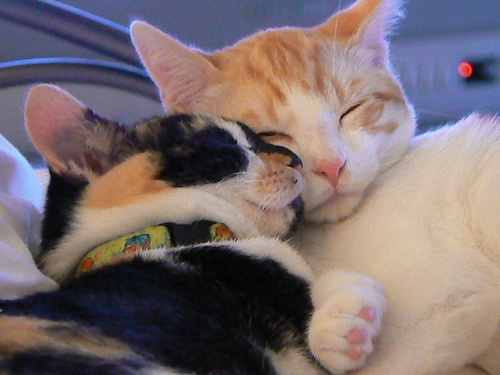Blog
How to Read a Cat
November 9, 2011

You can’t judge a book by its cover, but you can learn an awful lot about a cat just by looking at her. Are they happy? Sad? Angry? Afraid? Stressed? A quick glance can tell you these things and more. People are used to communicating vocally or verbally, but we are all aware of body language, at least subconsciously. While animals communicate vocally as well, they often tell you far more with their bodies.
Cats greet their friends head-on. Extending the head forward encourages touch. Cats will head-butt and head-rub-friendly cats and humans alike. This often extends into a full body rub. A cat that is aggressive may raise their head as well, while a cat that is submissive will lower their head to appear non-threatening. The head is only one part of the message, though, and to understand fully it is important to look at the cat’s posture, tail, and ears as well.
Ears, whiskers, and mouth also communicate a lot. A relaxed cat will usually sit with his ears up and forward, while flattening the ears can indicate fear, and turning the ears back can indicate aggression. Whiskers on a calm or happy cat will be pricked forward, but the more nervous a cat gets, the more it will draw its whiskers back alongside its face.
Ever wonder how a cat that walks into a room full of people inevitably knows and approaches the person who doesn’t like cats? The eyes might be the key here. While people usually like eye contact and see it as friendly, cats do not agree. When a cat enters the room, all the people who like cats will look at her in anticipation. The people who don’t like cats, however, will look away. Cats view direct eye contact as a challenge. The cat views the indirect person as nonthreatening and will approach them first.
The tail is often a clear indicator of mood, relationship, and confidence. A cat that holds his tail low may be defensive or submissive. Holding the tail high is usually a sign of comfort and friendliness unless it is bristling which usually indicates anger or fear. Similarly, a cat with an erect, quivering tail is indicating excitement and joy. Slow, languid back and forth movement or a twitching tail-tip demonstrates interest, but a back and forth thrashing motion is a symbol of anger.
Most people are familiar with common cat postures. Confident, comfortable cats will stand at full height. A lower, flatter posture indicates fear or apprehension, whereas a higher, more arched back indicates aggression. The classic “Halloween cat” position with an arched back, bristling fur, and erect tail would be a cat that is extremely fearful and making a last-ditch effort at expressing their desire for you to back off before they either run or strikeout.
It is important to keep in mind that these are only guidelines. Every cat, just as every person, will have their own idiosyncrasies. For example, when my cat is extremely happy, she will puff up her tail as big as it can get in a move that would ordinarily appear fearful. She does this while purring away and drooling happily, though, so I think she’s just trying to create more surface area for me to pet. Environment and relationships often factor into what the full message is, as well. That said, this knowledge can help you decipher a little more about how a cat, familiar or strange, is feeling.



